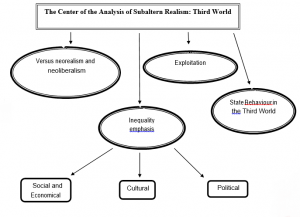Introduction
The term subaltern denotes inferior level or status within an order, on the other hand, the word subaltern came from Italian word ‘subaterno’. Subaltern implies to the populations that are outside of the hegemonic structure in terms of identity values, especially socially and politically.
Subaltern studies began with an attempt to apply the approach known as “history from below” in the Indian context and it emerged around 1982 as a series of journal articles. It has also inspired the formation of similar groups such as the Latin American Subaltern Studies.1 Subaltern studies were mainly included postcolonial studies and formed by mainly historians in India. After 1986, some groups known as Marxist historians within this study inclined to Marxist studies and others inclined to analyzes of the articles demonstrate ties among power, representation, identity and modernization. At the same time, tendency of subaltern studies has changed over time according to the audiences’ expectations. From the historical research pattern studying the colonial experience of the South Asian peoples and a model of intellectual discourse, subaltern studies turned into a post-colonial critique.
In time, subaltern indicated the colonized population of the Indian subcontinent and described a new standpoint of the history of an imperial colony. According to a lot of experts, the concept of the subaltern is problematic because it was originated as a Eurocentric method in historical process for studying the non-Western people. In discussions of the meaning of the “subaltern” in Gramsci’s works, many scholars have argued that he used the word as a synonym for the proletariat. For this reason, Ranajit Guha and subaltern studies were strongly influenced by the theories and works of Antonio Gramsci. In particular, it should be known that this study took inspiration from Antonio Gramsci’s work on “cultural hegemony”. At the beginning, Guha was influenced by the Chinese Cultural Revolution in the late 1960s and characterized Indian Maoism. They were also influenced by the English Marxist historical practice.2 However, Ranajit Guha rejected a Marxist teleological history definition arising from the emergence of class groups and industrialization. In doing so, building on the theories of Gramsci, Guha totally redefined subalternity as ‘expressed in terms of class, caste, age, gender and office or in any other way’.3 Guha also referred to this necessity in first Subaltern Studies volume, stating that ‘the historiography of Indian nationalism has for a long time been dominated by colonialist elitism and bourgeois – nationalist elitism’.4
The main goal of subaltern studies is to reconsider history for the underclasses. The scholars aspired to present a real story of subordinate people against the elitist understanding and Eurocentric insisting. According to them, history that is under the pressure of an imperialist hegemonic view ignores a lot of facts and merely reconstructs imperialist hegemony and does not give voice to the people. Therefore supporters of subaltern studies suggest that the scholars need to find substancial sources in order to locate the voice of the subaltern.
The West and The Others
The Eurocentric perspective who has a dominant power on ‘The Others’, used European cultural components and ideas to represent and describe ‘The Other’. Particularly, the main purpose was to emphasize the differences between the West and the others. In that process, the knowledge was also produced by such a discriminator perspective which then holds reality. Nowadays, the most powerful component in manufacturing that knowledge is ideology. The Clash of Civilizations is also a conflict of ideologies. The source of the divisions among the West and the others is also cultural as well as ideological. The origins of the West are imperial rules that established an artificial difference between the West and its colonies. In this direction, the idea of the West comes from colonization. By colonizing the new world, Europeans started to specify its borders, its superiority and its mission in the globe. For instance, Indies became “West Indies”, so “the West” was born. The new world were divided between the powers of the old world. Orientalism was used as a political and ideological tool for colonization. For many people, the West was responsible for bringing civilization to the rest of the world. On the other side, the Third World were substantially and negatively affected from this situation.
Most importantly, the colonial world was also conceived to reflect racial hierarchy. In the League of Nations mandate, colonial mandates are divided in three classes: A, B and C according to the development reached by the people and the amount of colonization they would need to attain full development.5 After World War II, the concept of West became a shelter for all ideologies. “The West” transformed a geopolitical, ideological and political reality. Also, during the Cold War, U.S. containment against communism, free market and post-fordism as an ideology became popular as a neo-colonial doctrine in the new world.
The cultural and hegemonic assumptions of colonialist logic remain activeness in contemporary society. Not only that, after the Cold War, the neo-cons declared the victory over communism in order to establish the full supremacy of the West cultural hegemony. This expansionist horizon, which is strongly and ideologically motivated, had ability to design a foe in order to justify its own actions and manoeuvres in the world. There are also the epitomes concerning this fact. It can be exemplified that the U.S. has shaped a new antagonist in the near east thereby playing an active role in providing logistical and training support to the terrorist organizations.6 To sum up, the distinction of “we and other” constructed Western- oriented building stones and rest of the world is seen as desperate versus these facts.
Subaltern Realist Theory
The main causes of current conflicts and state behaviours in the Third World are perhaps not existing popular research topic these days, but subaltern realist theory investigates it. The theory emphasizes the differences between conditions of the industrialized core states and the Third World, and the theory was also born in response to the neorealism of Kenneth Waltz and other scholars.
Within IR Theories, Mohammed Ayoob, who is known as a founder of theory of subaltern realism, analyzes the major determinants of state behaviour in the Third World. According to him, international relations reflects and reproduces the inequality present in the disposition of material capabilities in the international system. In this sense, power translates into domination in the sphere of the reproduction of knowledge. Domination in the arena of knowledge further legitimizes inequality in the international system because it increases the capabilities at the command of dominant states and societies by adding soft power to hard power. In addition, Third World states interactions are limited to their immediate neighborhood, particularly in the security sphere, and as such they will choose to interact with other states who possess similar characteristics. Therefore, they are much less concerned with security matters of an international level.7

Figure 1. The Primary Elements of Subaltern Realist Theory
Conclusion
Finally, Subaltern Studies, to attain authority as an effective voice in academic field, should expand its global cultural and area studies. This study is actually a comparative study. Nevertheless, it is debatable that the study had a universal image. Apart from that, as a discursive field Subaltern Studies has procreated a provocative research on the history of India, but it might be criticized with regards to the insufficiency of the concept and its impact in the Indian society and present society. Subaltern Studies claims that it can find Indian subalterns’ voices, indeed, referring to subalternity as a subaltern is a needed and considerable voice, however, the notion of inequality and class does not only belong to Indian people and society. Accordingly, it should not only be South Asian subaltern studies, also include in its scope whole world.
Nevertheless, Mohammed Ayoob selected the Third World as a research subject within the scope of subaltern realism. Finally, this approach in subaltern studies gravitated towards the causes of conflict in the Third World and Ayoob asserts an alternative conceptualization of security with new sets of questions in order to incorporate the Third World into mainstream international relations theories.
In brief, subaltern studies now focuses on how the knowledge of history was produced and how its construction can be decolonized. In raising these new questions, the scholars of subaltern studies realized that they could write history only from a position of subalternity because India, as a British colony, itself, was a subaltern.
Alparslan ULUHAN
Notes
1. McGrail, R. & Pillari, R., “Subaltern Studies”, http://www.culanth.org/curated_collections/6-subaltern-studies.
2. Sumit Sarkar, The Decline of the Subaltern in Subaltern Studies, Delhi: Oxford University Press, 1997, ss. 82-108.
3. Ranajit Guha, “Preface”, Subaltern Studies No 1.
4. Ranajit Guha, “On Some Aspects of the Historiography of Colonial India”, in Subaltern Studies No 1. 5, http://www.americanforeignrelations.com/E-N/Mandates-and-Trusteeships-League-of-nations-mandates.html.
6. Hürriyet Daily News, “New Yorker Article: US Administration supporting Iran-based PKK Group”, 20 November 2006.
7. Ayoob, M., “Inequality and Theorizing in International Relations: The Case for Subaltern Realism”, 2002, pp. 27-48.




















































